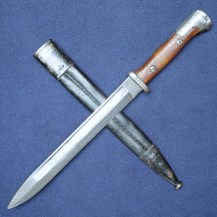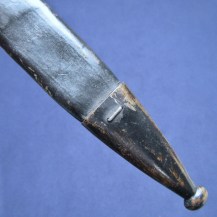German WW1 Mauser S84/98 a.A. Bayonet - Converted from S71/84
Single-fullered spear-pointed knife blade measuring 25cm (39cm overall), wood scale grips held by two screws. Scabbard of black leather with steel locket with frog hook and chape with oval finial, both painted black.
The ricasso of the blade is stamped on one side with the maker’s mark ‘Alex Coppel Solingen’, one of eight makers of the 71/84 pattern blade, and on the other side with a crown and ‘Danzig’, indicating the Danzig Gewehrfabrik, a military arsenal which carried out the conversion of many 71/84 bayonets into first-pattern 84/98 bayonets. The spine of the blade is stamped with a crowned ‘W’ over ‘88’, indicating that the blade was manufactured in 1888, a year in which three different kings ruled in Germany – Wilhelm I, who died on the 9th of March, his son Frederick II, who died on the 15th June, and grandson Wilhelm II.
The hilt is stamped with the unit mark ’_.R.13.20’ and on the scabbard with ’66.R.6.7’, indicating that the blade belonged with rifle number 20, 13th Company, of an unknown regular infantry regiment (wear or polishing has almost totally removed the regiment number) and the scabbard belonged with rifle number 7, 6th Company, 66th Reserve Infantry. That they are a non-matching pair indicates that the scabbard has been swapped from another bayonet of a different unit – perhaps a replacement during service. This is relatively common as leather scabbards were prone to wear and breakage in the field. The scabbard also has crown inspection stamps on the throat piece. The hilt is additionally stamped with ‘450’.
These bayonets were produced from 1909 to fit the Mauser M98 rifle. While they were a new type they made use of converted blades from the previous standard pattern bayonet, the 71/84, fitted to a new hilt and with the muzzle ring removed. These were issued with surplus scabbards of the previous model. As seen with the 71/84, the blades come in two variations with a long or short fuller – this example has the earlier short fuller which was produced until late 1888, after which the fullers were lengthened.
Once blade stocks ran dry the more abundant second model of 84/98 was produced, with a very similar knife blade and redesigned hilt. The 84/98 was the shortest bayonet to see use in WW1, and the same overall design continued through to the 84/98 bayonets for the Kar 98k of WW2.
The locking button is almost seized – it can be forced to move but will not spring back to its original position once depressed. I believe the internal spring may be broken or missing. The blade has some nicks to the edge, denting to the spine towards the point and old polishing marks overall. The hilt and pommel have some denting and patination. The wood grips have only a few small dents and one scratch next to the unit mark.



















